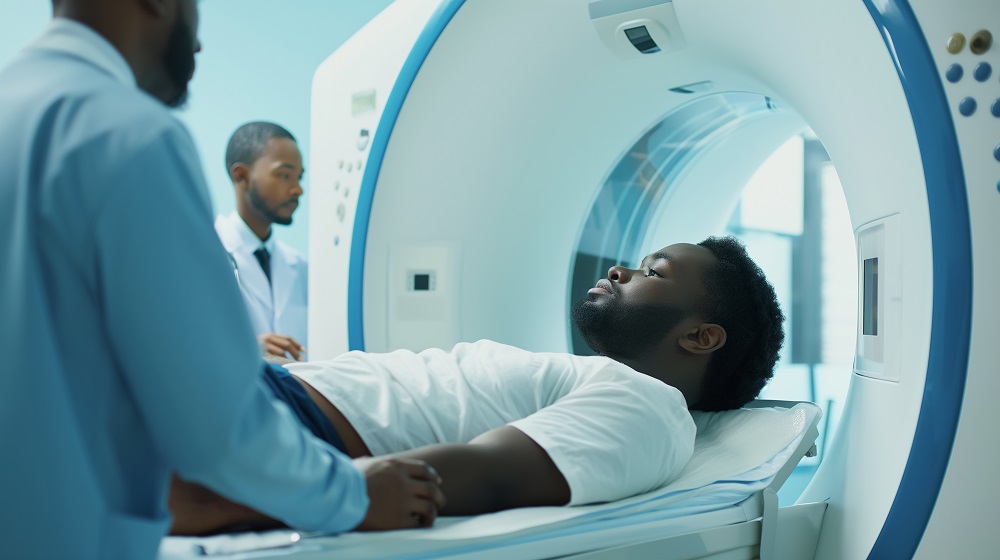CT Scans May Increase Cancer Risk, Study Reveals
By Adebowale Bello. B.Tech Microbiology, Freelance Health Writer. Medically reviewed by: A. Odutola, MBBS, PhD, FRCSEd.

A black man in white shirt being prepared by professionals for a CT scan. Image credit: Freepik.
Medical technology has come a long way, offering new hope for diagnosis and treatment. One such technology is the CT (computed tomography) scan. It gives a clear, 3D image of what’s happening inside the body, helping doctors diagnose issues from internal bleeding to cancer.
However, there’s a rising concern that more people, including those without urgent medical needs are undergoing CT scans unnecessarily and this could be putting their health at risk in the long term.
A recent study has brought this issue to light and while the study is based on CT scan use in the United States, the findings hold a warning for the rest of the world, including Africa, where access to medical imaging is rapidly increasing.
The study looked into the number of future cancer cases that could be caused by the radiation exposure from CT scans performed in 2023 in the US. Researchers analysed data from 93 million CT scans done on about 61.5 million people. They looked at 21 specific types of CT scans, such as scans of the chest, abdomen, head and pelvis
Their goal was to estimate how many of these scans might eventually lead to cancer and which types of scans carried the most risk.
According to the study, an estimated 103,000 future cancers may develop as a result of the CT scans performed in 2023. This represents one cancer for every 600 scans (or every 81 persons) and could make up 5% of all new cancer diagnoses if current scanning practices continue.
Lung cancer was revealed to be the most common radiation induced CT-related cancer (22,400 cases), followed by colon cancer (8,700), leukaemia (7,900) and bladder cancer (7,100) while in females, breast cancer was the second-most frequent CT-related cancer, accounting for 5,700 cases.
Abdominal and pelvic CT scans in adults were responsible for the highest number of projected cases in the future, about 37,500 while chest CTs came next, with 21,500 cases.
Although children and teenagers are more sensitive to radiation, 90% of these projected cancers are expected to occur in adults, simply because they undergo CT scans more often.
Another eye-opening point in the study was the impact of multiphase scanning, where patients are scanned multiple times during one session. This technique was used in nearly 1 in 3 scans, significantly increasing radiation exposure.
To understand why this matters, it’s helpful to compare radiation levels. A single CT scan exposes a person to about 10 millisieverts of radiation. In contrast, a regular X-ray gives off only about 0.1 millisieverts and natural background radiation over an entire year averages around 3 millisieverts.
This means a CT scan delivers more than three years’ worth of natural radiation in just one session. When this level of exposure is repeated, especially without medical necessity, it adds up thereby increasing the risk of radiation-related cancers.
While this study focuses on data from the US, the implications for Africans are real and pressing.
Across many African countries, access to advanced imaging like CT is improving. Governments and private healthcare providers are investing in new diagnostic tools to improve healthcare delivery. However, as CT use rises, so too does the risk of radiation-related complications if precautions are not taken.
Here are some key points:
This study adds to a growing body of evidence calling for “justification and optimisation” in medical imaging. Simply put, doctors should ask: Is this scan necessary? And if it is, how can we keep the radiation dose as low as possible?
African countries can take a number of steps to promote safer imaging practices:
CT scans are valuable tools that have saved countless lives, but like any medical intervention, they come with risks. The recent US study reminds us that even necessary medical technologies must be used with care.
For Africans, this is a timely reminder to strengthen our healthcare systems, improve training and educate both providers and the public on the safe use of medical imaging. As we embrace modern medicine, let’s also embrace responsible practices that protect lives in the long run.
Health professionals must act responsibly and only recommend CT scans when truly necessary. Patients, too, must feel empowered to ask questions about the purpose and safety of any imaging test they are offered.
In the end, it’s not about fear, it’s about making informed choices that protect both our present health and our future wellbeing.
Source: Smith-Bindman R, Chu PW, Azman Firdaus H, et al. Projected Lifetime Cancer Risks From Current Computed Tomography Imaging. JAMA Intern Med. Published online April 14, 2025. doi:10.1001/jamainternmed.2025.0505. Available from here.
Published: May 28, 2025
© 2025. Datelinehealth Africa Inc. All rights reserved.
Permission is given to copy, use and share content for non-commercial purposes without alteration or modification and subject to attribution as to source.
DATELINEHEALTH AFRICA INC., is a digital publisher for informational and educational purposes and does not offer personal medical care and advice. If you have a medical problem needing routine or emergency attention, call your doctor or local emergency services immediately, or visit the nearest emergency room or the nearest hospital. You should consult your professional healthcare provider before starting any nutrition, diet, exercise, fitness, medical or wellness program mentioned or referenced in the DatelinehealthAfrica website. Click here for more disclaimer notice.